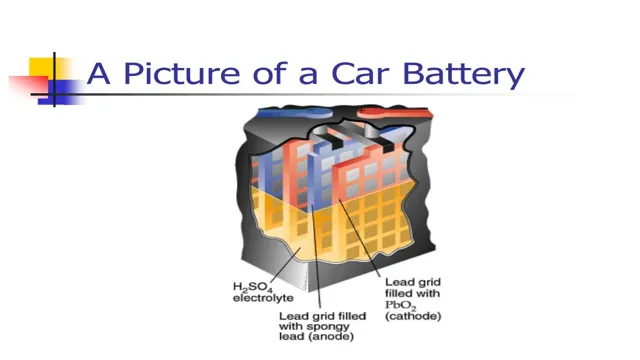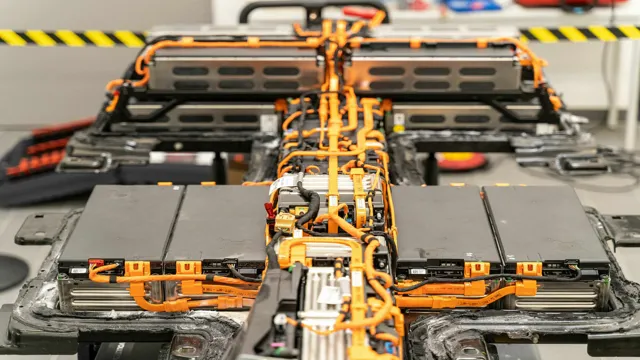The Shocking Truth: Understanding the Carbon Footprint of an Electric Car Battery
Have you ever wondered about the carbon footprint of your daily activities? Every action we take, from commuting to work to purchasing groceries, contributes to our carbon footprint. The carbon footprint is a measure of the amount of carbon dioxide and other greenhouse gases released into the atmosphere as a result of our actions. With climate change becoming more of a pressing issue, it’s important to understand our individual carbon footprints and take steps to reduce them.
In this blog, we’ll explore the concept of the carbon footprint, its impact on the environment, and practical ways to reduce it in our daily lives. So, grab a cup of coffee and join us on this journey towards a more sustainable future.
Electric Car Battery Production
The production of electric car batteries has been a hot topic in recent years, with concerns over the carbon footprint of the entire process. Although electric vehicles (EVs) produce much lower emissions when on the road compared to their gas-guzzling counterparts, the production of their batteries does require significant amounts of energy and raw materials. These materials, such as lithium, cobalt, and nickel, are mined from various parts of the world, often in environmentally damaging ways.
Furthermore, the energy and emissions required to refine and manufacture these materials are also substantial. However, it’s important to note that these concerns are not unique to EVs, but rather a broader issue within the manufacturing and production of consumer electronics and other technologies. Despite these challenges, the industry is taking steps to address these concerns, such as increasing the use of recycled materials and investing in renewable energy to power the production process.
In short, while the carbon footprint of electric car batteries is a valid concern, it should not detract from the overall benefits of electrification and the positive impact it can have on reducing emissions and improving air quality.
Raw Material Extraction
When it comes to electric car batteries, many people are unaware of the raw material extraction process involved in their production. The most common materials used in battery production are lithium, cobalt, and nickel, which are mined from various locations around the world. Sadly, the mining process can have harmful environmental and social impacts, particularly in developing countries where labor rights may not be respected, and pollution can wreak havoc on local communities.
Therefore, it is crucial that battery manufacturers enforce ethical and sustainable sourcing practices to protect both people and the planet. While it may be tempting to overlook the extraction process and focus solely on the end product, understanding the impact of raw material production is essential to ensure the creation of a truly eco-friendly electric vehicle.
Manufacturing Process
Electric car battery production is a complex process that involves multiple steps and stages. The manufacturing process usually starts with raw materials such as lithium, cobalt, and nickel. These materials are then converted into chemicals and processed further before being transformed into battery components such as cathodes, anodes, and electrolytes.
These components are then assembled together to form a battery pack, which is the heart of an electric car. The manufacturing process is highly automated to ensure accuracy, efficiency, and consistency. Quality control and testing are done throughout the process to ensure that the battery meets all safety, performance, and environmental standards.
The use of robots and advanced technologies has made the manufacturing process faster, cheaper, and more sustainable. The demand for electric car batteries is expected to grow rapidly in the coming years, and the industry is investing heavily in research and development to further improve the production process and reduce the cost of batteries.
Electric Car Battery Use
When it comes to electric cars, one of the most crucial components is the battery. While electric cars have long been praised for their environmentally-friendly status, there are still concerns surrounding the carbon footprint of an electric car battery. It’s important to note that the production of electric car batteries does result in emissions, particularly due to the mining and refining of the necessary metals.
However, studies have shown that overall, electric cars still have a significantly lower carbon footprint than their gasoline-powered counterparts. Additionally, initiatives are underway to improve the sustainability of electric car batteries, through the use of recycled materials and more efficient production processes. As electric cars continue to gain in popularity, it’s clear that their batteries will play a key role in the development of more sustainable transportation options.
Electricity Sources
Electric car batteries have become increasingly popular in recent years due to their environmental benefits and potential cost savings. However, the source of electricity that powers these batteries is just as important. While many people believe that electric cars are completely emission-free, that’s not entirely true.
The electricity used to power these vehicles has to come from somewhere, and depending on the source of electricity, the emissions produced can vary greatly. For example, if an electric car is charged using electricity generated from renewable sources such as wind or solar power, then the emissions produced are virtually zero. However, if the electricity comes from a coal-fired power plant, then the emissions produced can be higher than those from a gasoline-powered car.
Therefore, it’s important to consider the source of the electricity used to charge an electric car battery before making a decision to purchase one. By doing so, we can make an informed decision that not only benefits our wallets but also the environment.
Battery Lifespan
As we move towards environmental sustainability, electric cars are becoming more prevalent. However, one of the main concerns of prospective buyers is the battery lifespan. They may wonder how long an electric car battery lasts and if it’s worth the investment in the long run.
The good news is that electric car batteries have a relatively long lifespan and can last between 7-10 years or more. Of course, this depends on various factors like usage, weather conditions, and maintenance practices. In comparison to conventional cars with four or five-year battery lifespans, electric cars are a more sound investment.
To increase the lifespan of your battery, you should avoid extreme temperatures, ensure efficient charging practices, and keep up with maintenance checks. By following these tips, you can maximize the use of your electric car battery and get the most out of your investment.
Driving Behavior
Electric car drivers need to pay attention to their driving behavior to increase the longevity of their car’s battery. Accelerating and driving at high speeds can drain the battery quickly, while gentle acceleration and maintaining a consistent speed can help extend its life. It’s also important to avoid harsh braking and rapid deceleration, as well as excessive use of air conditioning or heating, as they also use up the battery’s charge.
Additionally, planning routes that avoid traffic congestion and charging the battery only when necessary can be helpful in optimizing battery usage. By being mindful of their driving habits and taking steps to conserve energy, electric car drivers can make the most of their car’s battery and enjoy long, efficient drives without worrying about running out of power.
Comparing to Gasoline Cars
When it comes to comparing the carbon footprint of an electric car battery to that of a gasoline car, there’s a stark difference. Electric cars emit zero emissions than gasoline engines that produce air pollution and greenhouse gases that impact the environment. While electric cars do use electricity generated from power plants, they can still produce significantly fewer emissions per mile traveled than gasoline cars.
In terms of manufacturing the batteries for electric cars, some concerns have been raised with the extraction of rare metals needed for manufacturing. However, strides are being made in recycling these materials, reducing waste, and improving sustainability in the battery production process. Overall, electric cars have the potential to significantly reduce carbon emissions and contribute positively to the efforts to combat climate change.
Life Cycle Assessment
When it comes to comparing the life cycle assessment of electric cars to gasoline cars, there are several factors to consider. Electric cars have a much lower carbon footprint in terms of emissions, as they run on electricity instead of gasoline. However, the overall life cycle impact must also be considered, including the manufacturing process of the car, the energy used to charge the battery, and the eventual disposal of the car.
While electric cars may have a higher impact during the manufacturing process due to the production of the battery, they typically have a longer lifespan and require less overall maintenance than gasoline cars. Additionally, as the grid becomes cleaner and more renewable sources of energy are used to generate electricity, the environmental impact of electric cars will continue to decrease. Ultimately, the life cycle assessment of electric cars compared to gasoline cars shows that electric cars are a more sustainable choice for the future of transportation.
Environmental Impact
When comparing electric cars and gasoline cars, it is impossible not to examine their environmental impact. Electric cars are often touted as the greener option, but how do they stack up against their gasoline counterparts? The truth is, electric cars are much better for the environment. Gasoline cars release harmful emissions into the air that contribute to air pollution and global warming.
Electric cars, on the other hand, release zero emissions while driving. This means that over the life of the car, an electric car will produce significantly fewer greenhouse gas emissions than a gasoline car. Plus, as the world continues to shift towards renewable energy sources, electric cars will become even cleaner as their power comes from increasingly renewable sources like wind and solar power.
In short, if you care about the environment, an electric car is the way to go.
Conclusion
In the world of carbon footprints, electric car batteries are like the trail runners of the environmental movement. Sure, they leave a mark, but it’s more like a gentle nudge than a heavy footprint. By reducing our reliance on fossil fuels and embracing renewable energy sources, electric cars help mitigate the damage we’re doing to the planet.
So, while the production and disposal of electric car batteries do have an impact, the positives they bring far outweigh the negatives. It’s time to lace up and hit the trails towards a cleaner, greener future.”
FAQs
What is a carbon footprint?
A carbon footprint is the amount of greenhouse gas emissions that are released into the atmosphere as a result of human activity.
How is the carbon footprint of an electric car battery calculated?
The carbon footprint of an electric car battery is calculated by considering the emissions from the production, transportation, and disposal of the battery, as well as the emissions from the electricity used to charge the battery throughout its lifetime.
How does the carbon footprint of an electric car battery compare to that of a gasoline-powered car?
The carbon footprint of an electric car battery is generally lower than that of a gasoline-powered car, because electric cars emit fewer emissions during use. However, the carbon footprint of the battery production process may be higher than that of a gasoline-powered car’s production process.
Can the carbon footprint of an electric car battery be reduced?
Yes, the carbon footprint of an electric car battery can be reduced by using renewable energy to power the battery production process, improving energy efficiency during production and transportation, and recycling the battery at the end of its life.



